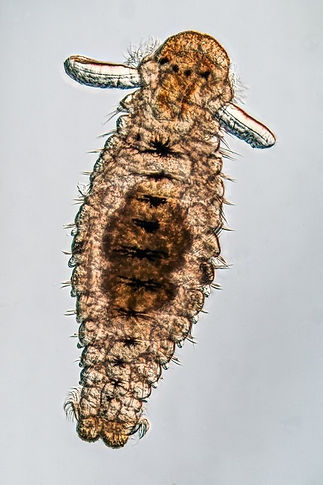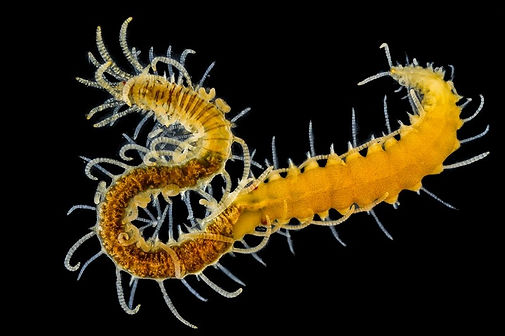Polychaete larvae

Early trochophore, 80 microns
The first stage of a planktonic polychaete larva is the trochophore. As they begin to develop the typical polychaete bristles, the chaetae, the become known as a nectochaete.

Polychaetes
These true worms are exclusively marine and constitute a major part of the zooplankton biomass. Within Milford Haven the typical forms are larval but occasionally a few holoplankton species, highly adapted for a permanent pelagic existence, occur. They are also very spectacular. Some polychaetes have strange and complex life cycles.
Tomopteris is an especially beautiful creature and can reach 2cm in length. It is a predator feeding on tunicates, arrow worms and other suitable zooplankton. The red eyes have distinct lenses. It is transparent other than these and yellow on the ends of the parapodia. These are glands and are luminescent.

Tomopteris




Maggelona is also a spionid. The larvae have two long palps, here coiled up. It is a predator on bivalve veligers, abundant in the Haven

Distinctive trochophore, body 90 microns, of Sabellaria. Abundant in Haven

1

2

3
The polychaete Malacoceros: 1. is an egg common in the spring plankton. 2. is the developed trochophore with 2 eyespots and a ciliary band at the broadest point (the telotroch). 3. with chaetae now developing this is a nectochaete stage. As segments are added so the larva increases in length.

A Spionid larva, possibly Polydora, common in plankton samples

Possible larva of Capitella

Some Strange Life Cycles
The Epitokous Planktonic Phase of a Syllid



The male stolon called a polybostrichus showing the characteristic bifid antenna
Myrianida (also known as Autolytus) is a genus of the family Syllidae and common in the lower rocky shore living in mucus tubes. They are quite inconspicuous at around 10 mm and are predators especially on hydroids, the best place to find them. These delightful worms do not contain gonads but produce new individuals at the end of the body like a strange yellow extension complete with eyes. These are called stolons and are the sexual phase. It is possible to have chains of these but I have only ever found one attached (see photo) and while taking this photo the stock adult severed the "umbilical cord" and discharged the stolon into the plankton.
The stock worms are separate sexes and produce either male or female stolons. These non-feeding forms quickly mature within the plankton to become distinctly different. The male is called a polybostrichus and the female a sacconereis. After mating the polybostrichus dies while the sacconereis nurtures and broods the eggs in a sac – just visible in the photo. Once the eggs hatch she will die, an entire process (called epitoky) taking around a month.

The female stolon called a sacconereis, brooding eggs
The Planktonic Phases of the Sand Mason (Lanice conchilega)


A closeup of a late aulophora larval tube encrusted in diatom frustules

The adult worms are extremely common on sandy shores around Pembrokeshire and especially so in Milford Haven. They create a spectacular tube from sand grains, shells and forams. These are seen with the top section protruding from the sand at low tide. The life cycle is complex as the aulophora larva lives in a tube in the plankton after a series of trochophore changes. After a short period of development it settles but then forms a second aulophora stage. The hyaline tube provides buoyancy and over time is encrusted in debris, especially diatoms on which it feeds.

Aulophora larva at the front of its hyaline tube
